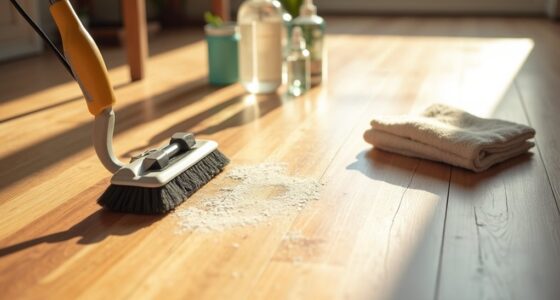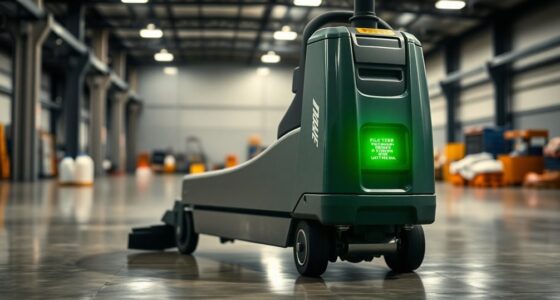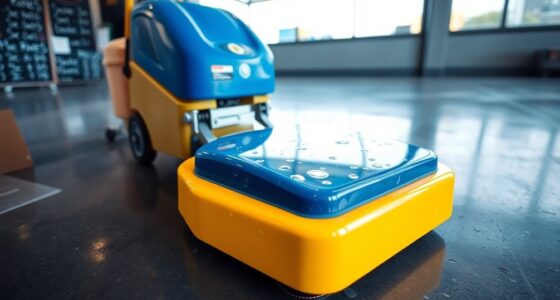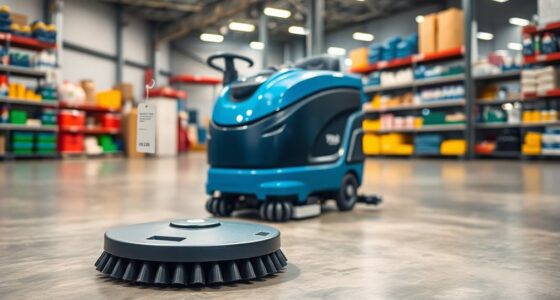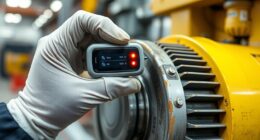Transform your cleaning routine by following essential floor scrubber tips. Start with pre-use maintenance by checking the squeegee, brushes, and battery. Keep your tanks clean to avoid chemical buildup and blockages. Don't overlook the importance of regular squeegee and pad inspections to ensure effective cleaning. Maintain your filters to prevent interruptions during use, and adopt best practices for battery care to prolong lifespan. There's more you can discover to enhance your cleaning efficiency.
Key Takeaways
- Regularly inspect and maintain squeegee blades and pads to enhance cleaning efficiency and prevent dirt buildup.
- Empty and rinse solution and recovery tanks after use to avoid chemical residue and odors.
- Use low-foaming detergents suitable for your floor type, following manufacturer guidelines for optimal results.
- Charge batteries fully after each use and maintain a log to ensure longevity and performance.
- Check and clean filters daily to prevent blockages and maintain uninterrupted cleaning effectiveness.
Essential Pre-Use Maintenance for Optimal Performance
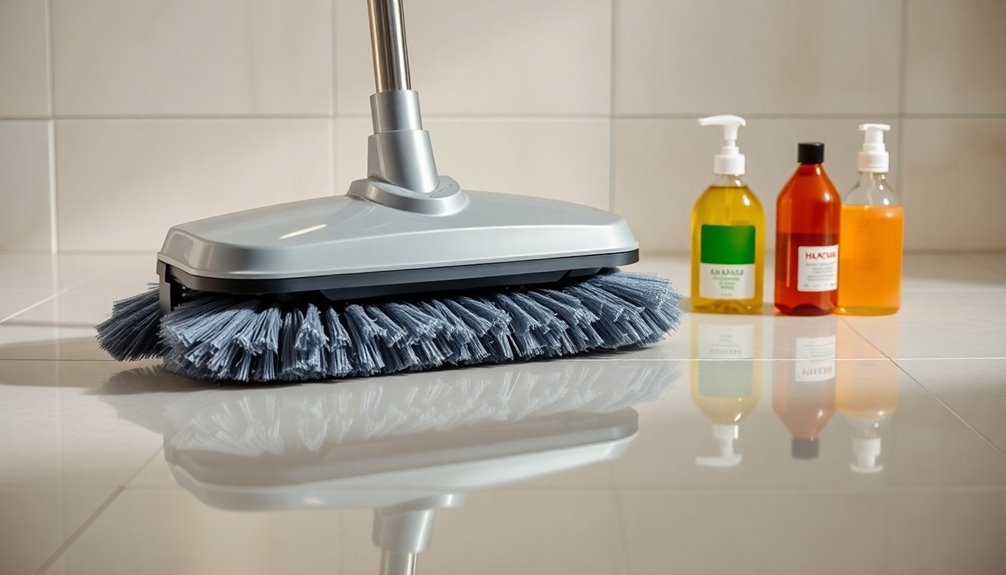
Before you start using your floor scrubber, it's crucial to perform essential pre-use maintenance to ensure optimal performance.
First, inspect the squeegee blade for cracks or wear; flip or replace it as needed.
Next, verify the condition of brushes or pads—clean, rotate, or replace them to avoid clogging. Proper pad/brush selection is key to achieving the best cleaning results.
Check your battery status; ensure it's fully charged and that deep-cycle batteries have adequate distilled water.
Confirm you're using the right cleaning chemicals for your floor type to prevent damage.
Lastly, pre-sweep the area to remove any debris that could harm the scrubber.
Keeping Your Tanks Clean and Efficient
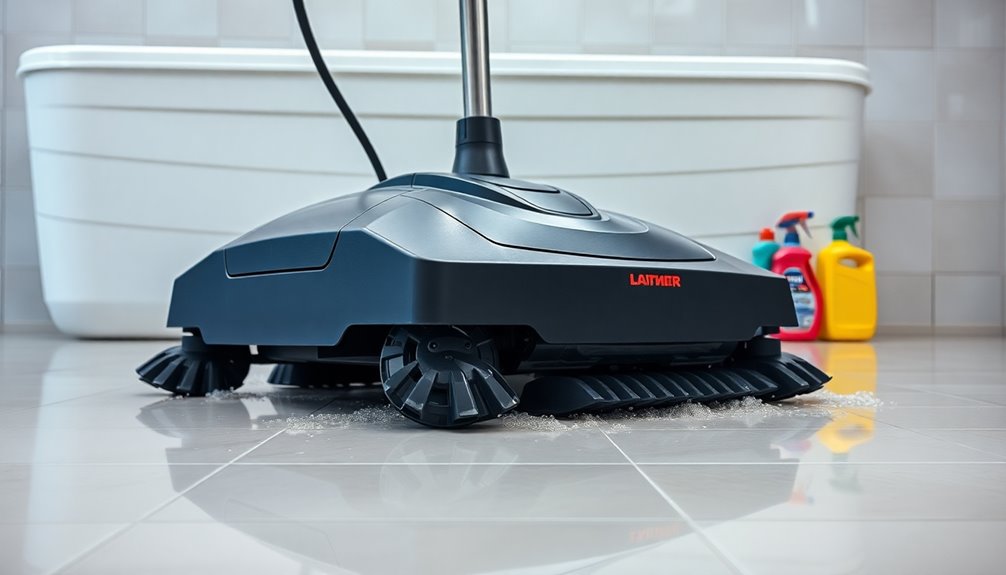
To keep your floor scrubber running efficiently, it's essential to maintain both the solution and recovery tanks regularly. Empty these tanks after each use to prevent chemical buildup and ensure optimal performance. Rinse them thoroughly with a hose to remove any lingering dirt or detergent residue. Regular cleaning of the recovery tank is crucial to avoid muddy buildup and solidification of dirt. Remember to ventilate the tanks by leaving the lids open, which helps prevent mold and odors. Regularly check for blockages in the water flow from the solution tank and monitor levels during cleaning. Using low-foaming detergents and following manufacturer guidelines for concentration can also help maintain tank efficiency.
Importance of Squeegee and Pad Maintenance
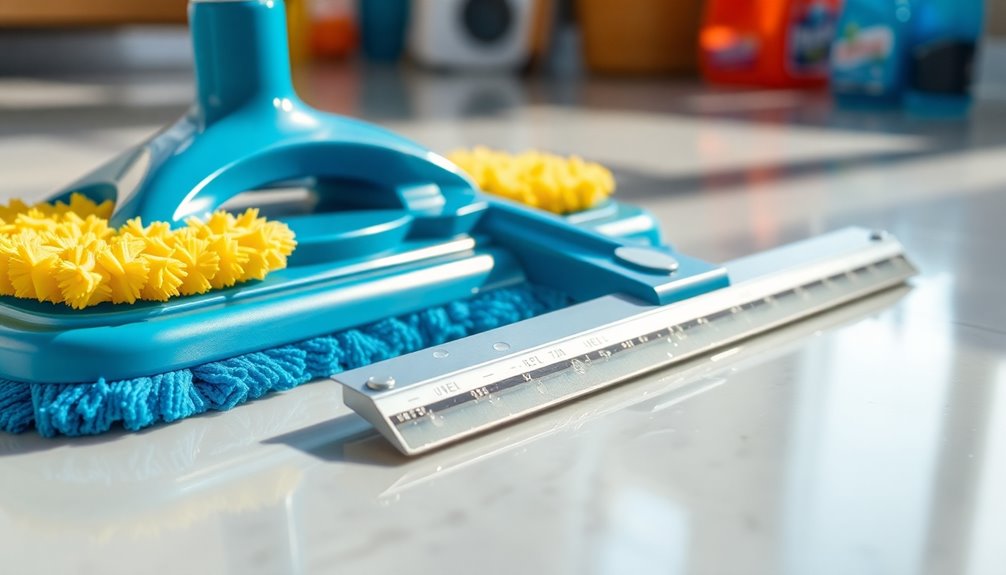
While maintaining your floor scrubber's squeegees and pads may seem like a minor detail, it plays a crucial role in achieving optimal cleaning performance.
Regularly inspect squeegees for wear and tear, and clean the blades to prevent dirt buildup. Proper storage in a dry area is essential to avoid mold or mildew. Additionally, conduct a daily inspection of your equipment to address any potential issues before they escalate.
When it comes to pads or brushes, choose the right type for effective cleaning and clean them frequently to remove debris. Inspect for wear and replace as needed to ensure efficiency.
Following these maintenance practices not only enhances water recovery and cleaning results but also reduces downtime and extends your equipment's lifespan, ultimately saving you money over time.
Filter Care: Ensuring Uninterrupted Cleaning

Maintaining your floor scrubber's filters is essential for ensuring uninterrupted cleaning and optimal performance.
Start by inspecting the solution, suction, and waste basket filters daily for any blockages or damage. After each use, rinse them under running water to remove accumulated debris; using a jet of water can be particularly effective. Additionally, regular cleaning of the scrubber and its components helps to enhance the effectiveness of the filters.
Always follow the manufacturer's guidelines for replacement intervals to avoid issues like clogged filters, which can impact suction power and cleaning efficiency.
Regular filter care not only maintains airflow and dust control but also prevents costly maintenance down the line.
Best Practices for Battery Maintenance
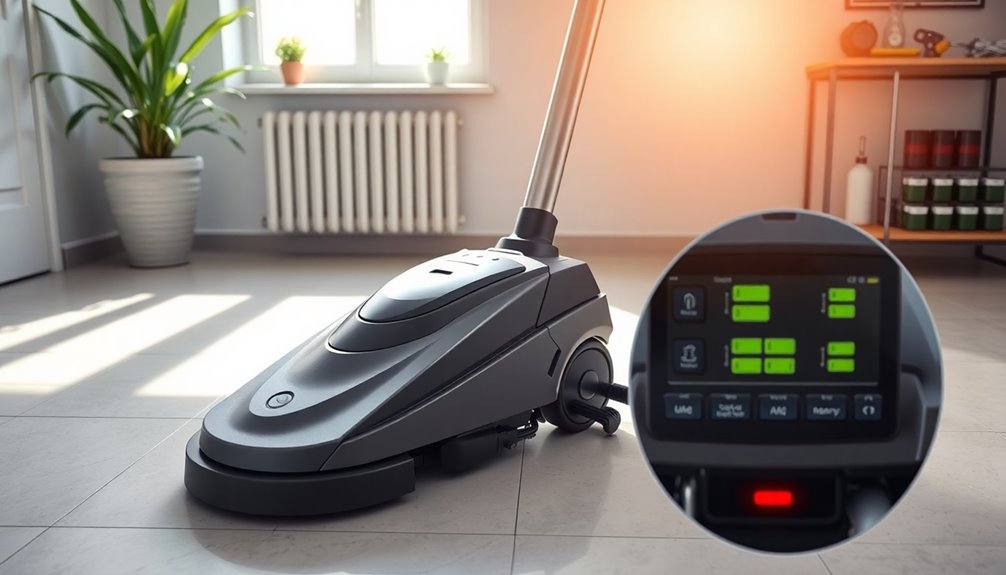
After ensuring your floor scrubber's filters are in top shape, it's time to focus on battery maintenance for optimal performance.
Always charge your battery after each use to start with a full charge, but avoid partial charging, which can harm performance. Use the correct charger to prevent overcharging and overheating, and keep your battery between 20% and 80% charged. Charging the Battery is essential to enhance the lifespan of your battery.
Store batteries in a cool, dry place to avoid moisture and extreme temperatures. Regularly inspect and clean your batteries to prevent corrosion and grime buildup.
Don't forget to check water levels for deep-cycle batteries and perform equalizer charges as needed. Keeping a maintenance log helps track the overall health of your battery, ensuring longevity and efficiency.
Enhancing Operational Efficiency for Lasting Results

To enhance operational efficiency and achieve lasting results with your floor scrubber, it's essential to adopt effective cleaning methods and preparation techniques.
Start by removing mats and equipment to prevent damage and pre-sweep the floor to eliminate debris. This helps avoid unnecessary wear on your scrubber and ensures the cleaning solution works effectively. Regularly inspecting the squeegee for cracks or wear is also important to avoid streaking during cleaning.
When you scrub, use straight, parallel lines with slight overlaps, and begin your path opposite the exit door to save time.
Regular maintenance is crucial, too; drain and rinse tanks after each use and check for wear on parts.
Frequently Asked Questions
How Often Should I Replace My Floor Scrubber's Pads or Brushes?
You should replace your floor scrubber's pads or brushes based on several factors.
Typically, if pads wear down to less than 10mm thick or lose their top layer, it's time for a change.
High-traffic areas require more frequent replacements.
Keep an eye on usage patterns and inspect for visible wear.
Regular cleaning and proper storage can also extend their lifespan, ensuring your scrubber performs efficiently.
Can I Use Any Cleaning Solution With My Floor Scrubber?
You can't just use any cleaning solution with your floor scrubber.
It's essential to choose a detergent that's compatible with your specific machine and the type of floor you're cleaning. Low-foam, biodegradable options are best, and always follow the manufacturer's guidelines on concentration.
Using the wrong detergent can damage your scrubber or the floor, so make sure you're selecting the right product for effective and safe cleaning.
What Should I Do if My Floor Scrubber Is Not Picking up Water?
Imagine your floor scrubber as a trusty ship, supposed to glide smoothly across the waves of water, but instead, it's stranded.
If it's not picking up water, inspect the squeegee for damage, clear any blockages in the vacuum hose, and check the recovery tank's fullness.
Ensure the vacuum system's working properly too.
How Can I Prevent Cross-Contamination While Cleaning?
To prevent cross-contamination while cleaning, start by using separate tools for different areas and implementing a color coding system.
Regularly clean your equipment, especially pads and brushes, to maintain their effectiveness.
Make sure you practice good hand hygiene before and after cleaning tasks.
Establish a routine cleaning schedule, and always prepare surfaces before scrubbing to ensure optimal results.
What Are the Signs That My Battery Needs Replacement?
If you notice your battery's run time has significantly decreased, or it's not charging fully, it might be time for a replacement.
Look out for physical damage like cracks or corrosion, as these can compromise performance.
If your machine's efficiency drops and requires frequent maintenance, that's another sign.
Regularly inspect connections too; loose wires could affect performance.
Keep an eye on these signs to ensure your equipment runs smoothly.
Conclusion
By following these floor scrubber tips, you're not just maintaining a machine; you're nurturing a trusted partner in your cleaning routine. Think of it like caring for a classic car—regular upkeep keeps it running smoothly and looking great. Just as a vintage ride turns heads, a spotless floor reflects your commitment to excellence. So, invest a little time in your scrubber, and enjoy the lasting results that come with a well-maintained cleaning ally!


